12.48.520 Building details.
A. Purpose.
1. To encourage the incorporation of design details and small-scale elements into building façades that are attractive at a pedestrian scale.
2. To integrate window design that adds depth, richness, and visual interest to the façade.
B. Façade Details – Nonresidential and Mixed-Use Buildings. All building façades and other building elevations facing parks, publicly accessible outdoor spaces, and containing primary building entrances must be enhanced with appropriate details. All new buildings must employ at least one detail element from each of the three categories below for each façade articulation interval (see BMC 12.48.510(B)).
1. Window and/or entry treatment, such as:
a. Transom windows.
b. Roll-up windows/doors.
c. Recessed entry.
d. Decorative door.
e. Other decorative or specially designed window, shading or entry treatment that meets the purpose of the regulations.
Fig. 12.48.520.B.1. Examples of decorative or specially designed windows and entries.

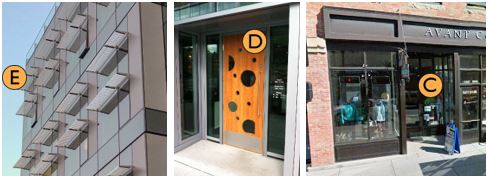
2. Building elements and façade details, such as:
a. Custom-designed weather protection element such as a steel canopy, glass, or retractable awning. Custom-designed cloth awnings may be counted as a detail provided they are constructed of durable, high-quality material.
b. Decorative building-mounted light fixtures.
c. Bay windows, trellises, towers, and similar elements.
d. Other details or elements that meet the purpose of these regulations.
Fig. 12.48.520.B.2. Examples of attached elements that enhance the visual intrigue of the building.
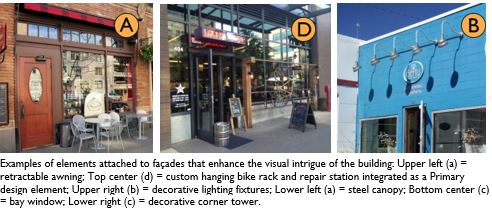

3. Building materials and other façade elements, such as:
a. Use of decorative building materials/use of building materials. Examples include decorative use of brick, tile, or stonework.
b. Decorative kick-plate, pilaster, base panel, or other similar feature.
c. Hand-crafted material, such as special wrought iron or carved wood.
d. Other details that meet the purpose of the regulations.
Fig. 12.48.520.B.3. Examples of building material details that enhance the visual intrigue of the building.
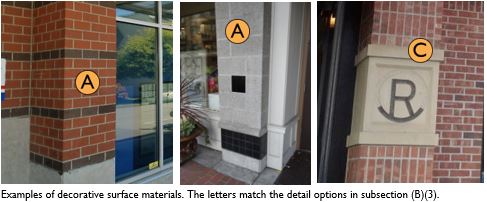

Departures for façade detail regulations of this subsection B will be considered provided the façade (at the overall scale and at the individual articulation scale) meets the purpose of the regulations.
C. Window Design Regulations. All windows must employ designs that add depth and richness to the building façade. At least one of the following features must be included to meet this requirement:
1. Recess windows at least one and one-half inches from the façade.
2. Incorporate window trim (at least three inches wide) around windows.
3. Incorporate other design treatments that add depth, richness, and visual interest to the façade.
Fig. 12.48.520.C. Acceptable and unacceptable window design examples.
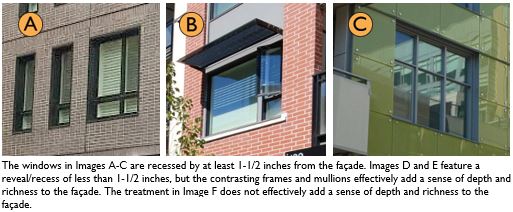

D. Cornice/Roofline Design. Buildings employing a flat roof must employ a distinctive roofline that effectively provides an identifiable “top” to the building. This could include a traditional cornice line or a contemporary interpretation of a traditional cornice line.
1. Such rooflines must be proportional to the size and scale of the building.
2. Understated cornice lines are permitted depending on the materials and design of the base and middle elements in reinforcing the base/middle/top configuration.
Figure 12.48.520.D below illustrates acceptable and unacceptable examples.
Fig. 12.48.520.D. Examples of buildings employing confident and distinctive rooflines.
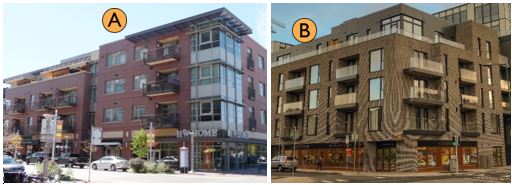

Rooftop solar units are permitted, provided the placement and design of units visible from the surrounding streetscape are carefully integrated into the overall design concept of the building.
E. Articulated Building Entries. The primary building entrance for an office building, hotel, apartment building, public or community-based facility or other multi-story commercial building must be designed as a clearly defined and demarcated standout architectural feature of the building. Such entrances must be easily distinguishable from regular storefront entrances on the building. Such entries must be scaled proportional to the building. See Figure 19.123.250.E below for good examples.
Fig. 12.48.520.E. Acceptable building entry examples.
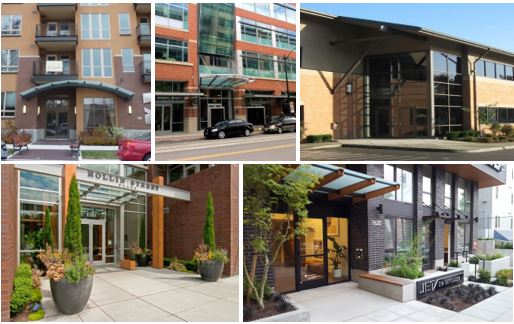
F. Flat Rooftop Design. All roofs must be designed as a fifth building elevation. This can be accomplished by exhibiting patterns of roofing colors and/or materials to add visual interest from surrounding development (current and future). Green roofs and rooftop decks are encouraged as a means to help comply with this standard.
Fig. 12.48.520.F. Flat rooftop design examples.
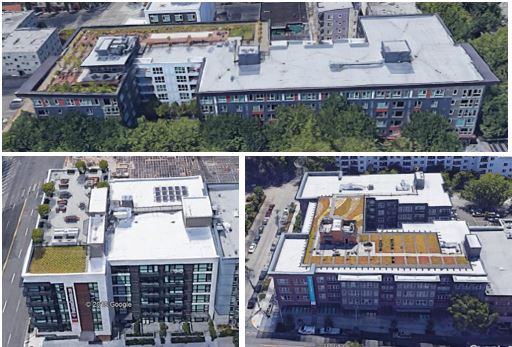
(Ord. 2341 § 5 (Exh. A), 2020).